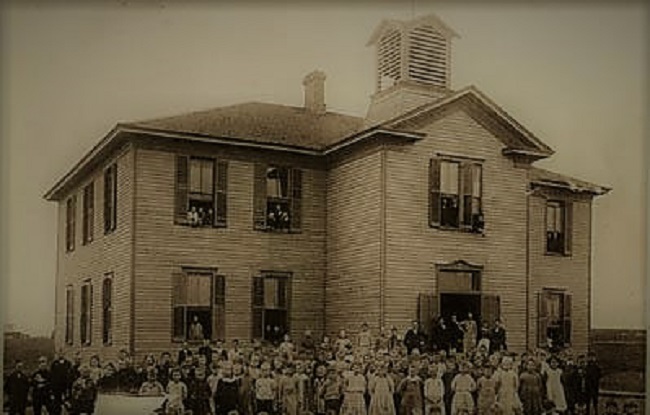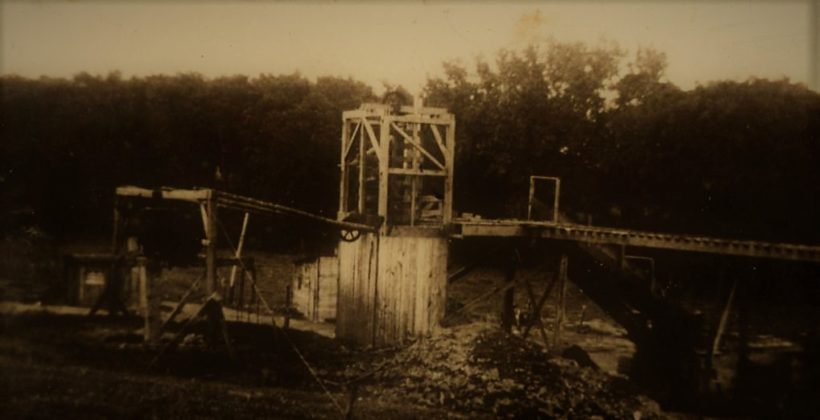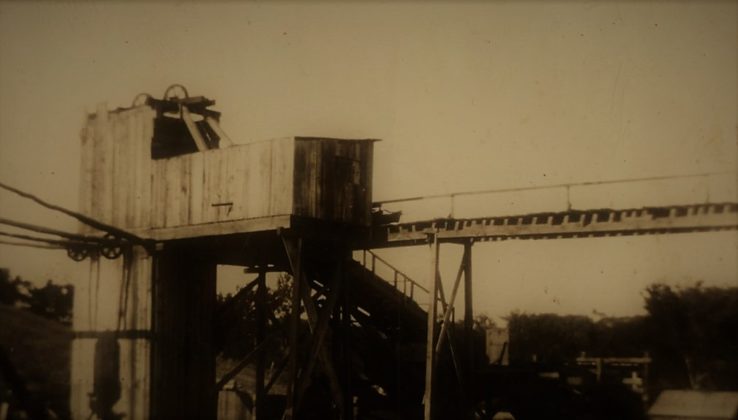
Before the railroad came through in 1869, there were a few small coal mines in the Angus area that sold coal to the settlers. At that time, there was a store owned by a big Swede by the name of Albert Johnson, and the place was called Coaltown, a very natural name.
When the Des Moines and Fort Dodge Railroad was built, Coaltown community seemed like
a good spot for a new town, and so it was started. The new town carried the same name until 1883, when John McKay, a railroad man and mine operator, changed the name to Angus after the region of Scotland of the same name.
In 1881 the Minneapolis and St. Louis Railroad came to Angus by way of Ogden and Berkley. At this time, Angus was the southern terminus, and from here to Des Moines the M & St L trains were sent over the Des Moines and Fort Dodge line.
The first big mine in Angus was sunk by John Duncombe, a capitalist from Fort Dodge, and in time he sold his interest to the Climax Coal Co., in which James Hill, the railroad magnate, was a major shareholder. At that time, Climax Coal was among the largest in the state, and at Angus the record of production for this company alone in one day was 80 flat cars, and 53 of that was lump coal.
It was not long before other companies were secretly drilling and securing options on tracts of land. Nine companies were soon mining in Angus, and coal was being shipped out day and night. Probably next to Climax in amount of coal produced in one day’s run was the Standard Mine, where John McKay Sr of Des Moines was superintendent.
McKay said that as nearly as he could remember, the largest amount of coal hoisted in one day from the Standard Mine was 650 tons. It is said that this company made as much as
$34,000 in one year out of its single mine.
The outlook was golden in promise and it was freely predicted that Angus would soon be the metropolis of the state with Des Moines a mere village in comparison.
The Minneapolis and St. Louis Railroad Co. had just built a line from Albert Lea, Minnesota, to Angus and had surveyed 200-300 miles southward toward its projected southern terminus in St. Louis. The line was even graded many miles south of Angus, and today the old piling for the crossing of the Raccoon River may still be seen.
When trouble overtook the M & St L Railroad, extension work was dropped. The Angus folks did not lose hope and faith in the future, however, as it was a year of railroad construction, and all things were headed toward Angus. The people were certain that the town would be a great railroad center because of its mineral resources, fine surrounding territory and admirable farming location.
O. M. Brockett, a prominent Des Moines attorney, was editor of the “Angus Tenderfoot” back in those days, and in his issue of July 24, 1884, he painted quite a picture of the hopes and ambitions of this booming town where coal was king.
The Moingona Coal Company has been quietly prospecting ever since the spring in Wirth’s Addition, the company owning the coal rights to that tract. The prospecting has been extensive and thorough, and it was claimed that the field is one of the most valuable yet found in Angus.
By the beginning of 1887, the town had begun to show remarkable evidence of decay. Several of the larger companies had closed down. Several stores had gone out of business, and the population had declined surprisingly. It was discouraging even to the “Black Diamond,” and its owner, a Mr. Lowrey, found it necessary to publish this warning in his paper:
So far the newspaper business in Angus has been dull and gives every indication that it will be much more so before the summer season is over. We have no reflections to cast upon our businessmen for not extending a more liberal support toward the paper. But to attempt to run a paper of any size such as the Diamond is and make a living out of it in Angus is beyond the powers of anyone. We have managed to make expenses, but we are not here for just that purpose and when we begin to find the necessary expense incurred in running it not forthcoming, we well lock up and put it on ice for the summer.
That warning was printed in the issue of May 27, 1887. A few weeks later, the paper was put on ice and although many summers have come and gone since then, the paper is still in cold storage.
The most exciting chapter in the history of Angus was that relating to the big strike that began in September 1884 and ended with a riot in January 1885. It was a troublesome period for everyone concerned. Backed by the Knights of Labor, every man walked out and demanded the usual fall raise of 12 1/2 cents in the price of mining, which the operators had refused to grant.
It was a complete shutdown. Offers of compromise and arbitration were rejected again and again. After several weeks of complete idleness, the operators made an attempt to bring a number of strike breakers into the town. What had been a quiet game of freeze out at once developed into a serious affair.
The bank that flourished in the palmy days went to the wall August 7, 1893. It was the period of the Cleveland panic. It was a private bank owned by A. T. Pearson, and its deposits consisted mainly of hard-earned savings accumulated over years of work. After months of anxiety and waiting, the depositors finally got back about 35 cents on the
dollar.
There were two churches in the town, a Methodist Episcopal and a Primitive Methodist, the latter of which was presided over by the Rev. William A. Morris, who came to Angus in 1883. About 1884 the Welsh Congregationalists built a church near the center of the town. This made two houses of worship with services in foreign tongues but none in English.
However, in that same year the Methodist Episcopal denomination erected a large and substantial building in the southwestern portion of town in Miller’s addition. It was then no longer necessary to use the South Angus and Maple Grove schoolhouses for services.
The last blow at Angus fell when the Minneapolis and St. Louis Railroad assumed control of the Des Moines and Fort Dodge line, formerly operated by the Rock Island. Previous to that time, Angus had been the terminus of the M & St L, and the engine and train crews of both lines made their headquarters there.
This only affected a half-dozen or so families, but it seemed to be the climax of bad luck and dashed forever all hope of the M & St L extending southward and making the town a division point.
The original incorporation lines were large and widely spaced, and all that is left today is a house or two here and there, miles apart from extreme points.The company houses on Red Hill are all gone. The yellow houses of the Standard Co. are all gone. Gone are all the houses of the Milwaukee Co.



















